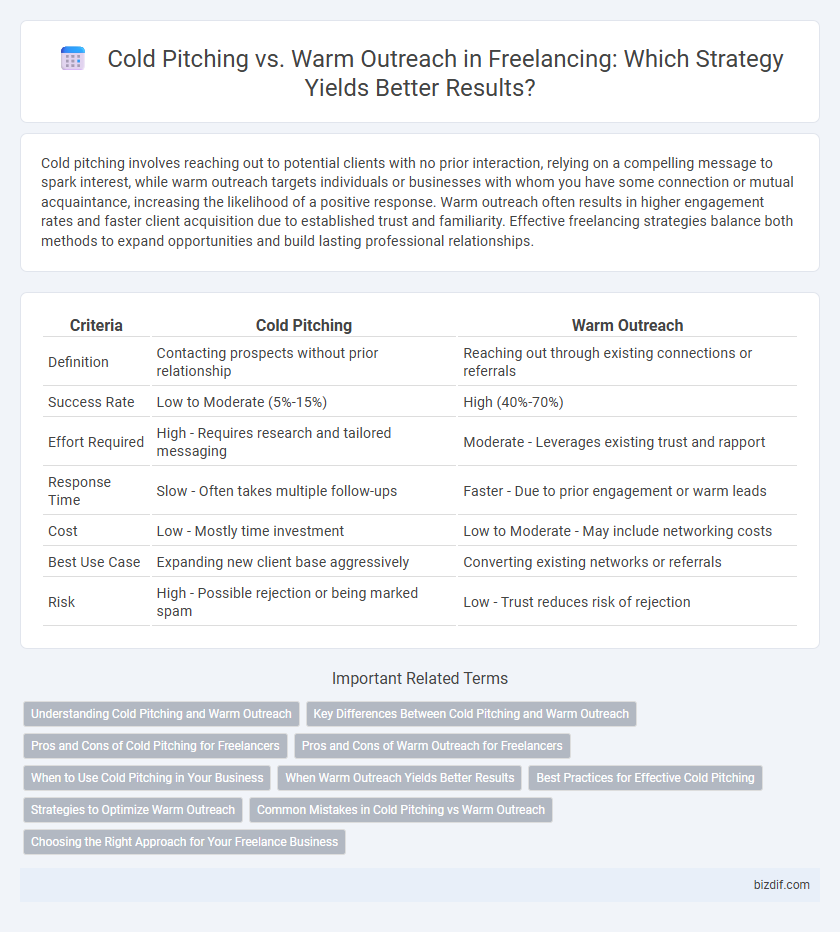Cold pitching involves reaching out to potential clients with no prior interaction, relying on a compelling message to spark interest, while warm outreach targets individuals or businesses with whom you have some connection or mutual acquaintance, increasing the likelihood of a positive response. Warm outreach often results in higher engagement rates and faster client acquisition due to established trust and familiarity. Effective freelancing strategies balance both methods to expand opportunities and build lasting professional relationships.
Table of Comparison
| Criteria | Cold Pitching | Warm Outreach |
|---|---|---|
| Definition | Contacting prospects without prior relationship | Reaching out through existing connections or referrals |
| Success Rate | Low to Moderate (5%-15%) | High (40%-70%) |
| Effort Required | High - Requires research and tailored messaging | Moderate - Leverages existing trust and rapport |
| Response Time | Slow - Often takes multiple follow-ups | Faster - Due to prior engagement or warm leads |
| Cost | Low - Mostly time investment | Low to Moderate - May include networking costs |
| Best Use Case | Expanding new client base aggressively | Converting existing networks or referrals |
| Risk | High - Possible rejection or being marked spam | Low - Trust reduces risk of rejection |
Understanding Cold Pitching and Warm Outreach
Cold pitching involves reaching out to potential clients without any prior contact or relationship, relying on well-crafted messages to capture attention and generate interest. Warm outreach targets prospects who have shown some level of engagement or familiarity with your work, increasing the likelihood of a positive response by leveraging existing connections. Understanding the nuances between cold pitching and warm outreach aids freelancers in selecting effective strategies to expand their client base and secure projects.
Key Differences Between Cold Pitching and Warm Outreach
Cold pitching involves contacting potential clients without any prior relationship or interaction, resulting in lower response rates and higher rejection risk. Warm outreach targets prospects with whom you have some level of familiarity or connection, leading to higher engagement, trust, and conversion rates. The key differences center on relationship status, personalized communication, and overall effectiveness in securing freelancing opportunities.
Pros and Cons of Cold Pitching for Freelancers
Cold pitching allows freelancers to reach a broad range of potential clients without prior connections, expanding their market opportunities rapidly. However, this approach often results in lower response rates and may require more time for follow-up communication, reducing overall efficiency. Despite its challenges, cold pitching provides a scalable method to acquire new projects and build a diverse client portfolio.
Pros and Cons of Warm Outreach for Freelancers
Warm outreach for freelancers leverages existing relationships or mutual connections, increasing the likelihood of positive responses and trust-building compared to cold pitching. This approach often results in higher engagement rates and more personalized communication, but it can be time-consuming and relies heavily on the strength of your network. However, limited reach and potential over-familiarity might reduce opportunities for discovering entirely new clients outside the current circle.
When to Use Cold Pitching in Your Business
Cold pitching is highly effective for freelancers targeting new clients in untapped markets or industries where previous relationships do not exist. It is best employed when there is a clear value proposition tailored to the prospect's specific needs, enabling personalized and compelling communication. Use cold pitching to expand your client base rapidly, especially when your portfolio or service offerings address niche problems that potential clients may not have considered.
When Warm Outreach Yields Better Results
Warm outreach yields better results when freelancers have established prior connections or mutual contacts, increasing trust and receptivity. Personalized messages referencing previous interactions or shared interests enhance engagement rates and response quality. Leveraging warm leads reduces friction in client acquisition, leading to higher conversion rates compared to cold pitching.
Best Practices for Effective Cold Pitching
Effective cold pitching in freelancing requires thorough research on potential clients to tailor your message precisely to their needs and demonstrate genuine value. Craft concise, clear pitches highlighting relevant skills and past successes, ensuring each message is personalized to bypass generic filters and increase engagement rates. Following up strategically without being intrusive helps maintain professionalism and keeps communication channels open for opportunities.
Strategies to Optimize Warm Outreach
Warm outreach strategies in freelancing emphasize personalized communication by leveraging existing relationships and previous interactions. Utilizing CRM tools to segment contacts and tailor messages based on client needs enhances engagement and response rates. Incorporating follow-up sequences and demonstrating clear value propositions further optimize warm outreach effectiveness, increasing project acquisition success.
Common Mistakes in Cold Pitching vs Warm Outreach
Common mistakes in cold pitching include generic messages that lack personalization and failing to research the recipient's needs, resulting in low response rates. In warm outreach, errors often involve over-relying on previous interactions without adding new value or being too aggressive in follow-ups. Both approaches suffer when freelancers neglect to tailor their communication strategy based on the relationship stage and client profile.
Choosing the Right Approach for Your Freelance Business
Cold pitching targets potential clients with no prior contact, offering a scalable way to expand your freelance business but often facing lower response rates. Warm outreach leverages existing relationships or mutual connections, boosting trust and improving conversion rates through personalized communication. Assess your network strength, industry norms, and time investment to determine the optimal balance between cold pitching and warm outreach for sustainable freelance growth.
Cold Pitching vs Warm Outreach Infographic

 bizdif.com
bizdif.com